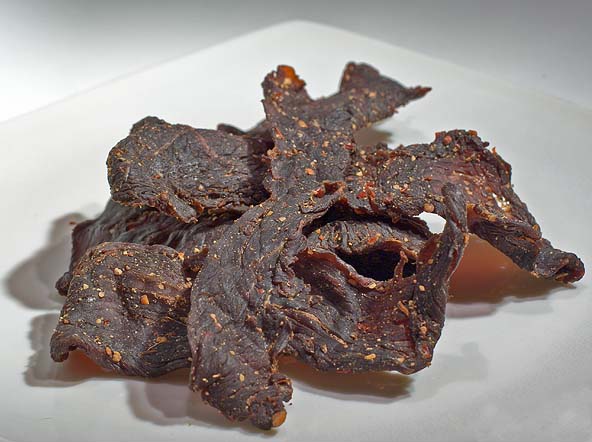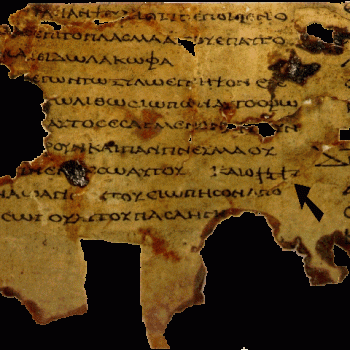Dried fish or meat, such as beef jerky (pictured above), have been eaten since very ancient times. [Wikimedia Commons /CC BY-SA 3.0]
* * * * *
How does one even come up with such a topic for a post? I’d never thought about this in my life, and I’ve been a seriously committed Christian for 35 years. Well, as usual, our atheist friends will make sure that every conceivable alleged disproof of biblical inspiration of Christianity will be trotted out for one and all to see.
It’s how they (former Christians) so often justify their departure from the Christian faith. They seem to really enjoy it. I don’t begrudge them their fun. We all have our pastimes. Admittedly, I have just as much fun shooting down the invariably paltry, fallacious, illogical “arguments” they come up with.
Linda LaScola, a prominent blogger in the Patheos Atheist Channel, presented an article featuring “Preston”: a “former fundamentalist (Southern Baptist).” He said that this “issue” was sufficient in “a few seconds” to cause him to reject the story of Noah’s Ark. That’s funny. It took me a “few seconds” as well to come up with what I think is a decisive refutation of his [original] dilemma / [in retrospect] disproof with regard to biblical Christianity.
In Linda’s post, Leaving Religion: Like Crumbling Jenga Blocks (9-10-15), Preston stated (complete with the obligatory cute and adorable picture of Noah’s Ark):
First block pulled from the stack: Biblical mythology
I remember the moment in 1995 that I realized that the story of Noah’s Ark was just an ancient hand-me-down ridiculous mythological tale.
I was a youth minister in a small Southern Baptist Church when a student asked:
“What did all the carnivores eat on Noah’s Ark for the entire year?”
I stumbled for a few seconds trying to give the best answer I could, but I knew that there could never be a sufficient answer to such a simple question. Any answer paled in comparison to the obvious: IT NEVER HAPPENED.
Okay, folks; there you have it. This was the first of a series of “jenga blocks” crumbling in Preston’s life, with the end result being, of course (big surprise!), atheism. He also wrote in the combox underneath the post, milking it for all it was worth:
Any attempt to answer those difficult questions require “magic”. You can solve any problem or argue your way out of an apologetic’s [sic] corner if you simply insert magic into the equation. Thats how I always rationalized mythical stories like Noah’s Ark. “God supplied the necessary food somehow. We dont [sic] know and we dont [sic] have to know”.
I’m sure all you Christians out there are trembling in abject terror, in existential anticipation of the same dreadful fate that Preston underwent, awaiting you! No need. This is not the longed-for “ultimate defeater” that atheists live and die for: one of those moments where they get in the beloved “zinger” that can destroy in one fell swoop (like Preston’s “jenga moments”) the infantile faith of yet more gullible Christians.
There is, I submit, a simple solution to this. But I think this one (along with several others mentioned below) is fairly decisive and satisfactory. Think of it for a moment. How have sailors — for millennia –, survived out at sea for months? The Wikipedia article, “Salt-cured meat” notes:
Salted meat was a staple of the mariner’s diet in the Age of Sail. [16th-19th centuries] It was stored in barrels, and often had to last for months spent out of sight of land. The basic Royal Navy diet consisted of salted beef, salted pork, ship’s biscuit, and oatmeal, . . .
Moreover, the Wikipedia article, “Dried and salted cod” states that:
The drying of food is the world’s oldest known preservation method, and dried fish has a storage life of several years. Traditionally, salt cod was dried only by the wind and the sun, hanging on wooden scaffolding or lying on clean cliffs or rocks near the seaside.
The cross-referenced article on “Drying” adds:
Drying is a method of food preservation in which food is dried (dehydrated or desiccated). Drying inhibits the growth of bacteria, yeasts, and mold through the removal of water. Dehydration has been used widely for this purpose since ancient times; the earliest known practice is 12,000 B.C. by inhabitants of the modern Middle East and Asia regions. Water is traditionally removed through evaporation (air drying, sun drying, smoking or wind drying), . . .
That gives us at least two methods of preserving meat or fish, known to the ancients, that would easily sustain carnivores, just as dog and cat food (dried meat) do the trick today. Cats in particular must have meat, and they do quite well with dry cat food. The Wikipedia article “Curing (food preservation)” informs us of the history of such preservation methods (including a third method: smoking), stretching back to antiquity:
Meat preservation (including livestock, game poultry), includes a set treatment processes for preserving nutritious properties, taste, texture and color of raw, partially cooked or cooked meats while keeping them edible and safe to consume.
The invention of such processes can be traced back to antiquity, . . .
Food curing dates back to ancient times, both in the form of smoked meat and salt-cured meat.
Several sources describe the salting of meat in the ancient Mediterranean world. Diodore of Sicily in his Bibliotheca historica wrote that the Cosséens in the mountains of Persia salted the flesh of carnivorous animals. Strabo indicates that people at Borsippa were catching bats and salting them to eat. The ancient Greeks prepared tarichos (τάριχος), which was meat and fish conserved by salt or other means. The Romans called this dish salsamentum – which term later included salted fat, the sauces and spices used for its preparation. There is also evidence of ancient sausage production. The Roman gourmet Apicius speaks of a sausage making technique involving œnogaros (a mixture of the fermented fish sauce garum with oil or wine). Preserved meats were furthermore a part of religious traditions: the extra meat used for offerings to the gods was salted before being given to priests, after which it could be picked up again by the offerer, or even sold in the butcher’s.
There is evidence of a trade in salt meat across ancient Europe. In Polybius‘s time, the Gauls exported salt pork each year to Rome in large quantities, where it was sold in different cuts: rear cuts, middle cuts, hams and sausages. This meat, after having been salted with the greatest care, was sometime smoked. . . .
The smoking of meat was a traditional practice in North America, where Plains Indians hung their meat at the top of their tipis to increase the amount of smoke coming into contact with the food.
If all that is not more than enough evidence, that this “disproof” falls flat, Richard Gabriel’s book, Soldiers’ Lives Through History: The Ancient World (Greenwood Publishing Group, 2007) provides two pages (pp. 32-33) on “Food Preservation.” On p. 32, he observed (mentioning a fourth option):
Salted meat and fish kept for months, as did smoked beef, ham, or fowl. A favorite ration of the Egyptian army was smoked gooseflesh. Pork and beef jerky kept for years. . . . Salting meat preserved it for as long as two years . . .
Pickling was another way of preserving meat, and we find references to it in Sumer, where ox joints were pickled for transport and sale.
Noah’s ark was afloat for about a year, according to the biblical accounts, so no problem: the carnivores could have had a steady supply of salted, dried, smoked, or pickled meat, which easily lasted that long. This should be more than sufficient to explode this myth that carnivores couldn’t possibly have survived on Noah’s Ark.
We know that Jesus mentioned “the salt of the earth” (Matthew 5:13). That was a reference to salt used in preserving foods. Metaphorically, the Christian prevented corruption. Magdala, on the Sea of Galilee, where Mary Magdalene came from (I actually ate fish from the Sea of Galilee not far from there, last year), had a prosperous fishing industry, including dried fish. Archaeologists even believe that they have found a tower there, the purpose of which was to dry out fish. But atheists usually don’t go down without a fight.
I suppose they could quibble about whether animals would eat all this weird dried, salted food. Here’s an article about how cats love beef jerky. They just need some extra water to go along with it. For those who say in reply (as indeed atheists already have) that dried / smoked / pickled / salted food would not be sufficient for some, many, or all carnivores, there are several other options that would provide fresh meat. More animals could have been brought on the ark for the sole purpose of being slaughtered and fed to the carnivores. The biblical text doesn’t preclude that possibility. Fish could be caught and fed to the animals. Offspring could be slaughtered for food, or parents slaughtered after giving birth. Animals that breed at a very high rate could have been kept. For example, Noah could also have bred many thousands of rabbits or mice in a year’s time.
None of these things are at all inconceivable. They are clear, unarguable available options. Moreover, there are animals that can go for a year or longer without food and/or water. These would be ideal for providing fresh meat and not depleting valuable resources. A National Geographic article noted that “like snakes, turtles are able to go for long periods without eating.” A website on Darwin’s famous Galápagos Islands stated:
The Galápagos tortoises can live up to a year without food or water. This made them a great food source for many of the ships that visited the islands in the 1800s. The sailors would collect the tortoises and keep them alive on board to serve as a source of fresh meat while at sea.
Another site noted similarly: “Adult desert tortoises can survive a year or more without access to water!” A web page about animals that can go a long time without food, informed readers that frogs can go without food for 16 months; spiders can last 18 months without food or water; snakes can last a year without food, and that crocodiles can last three years without food. See another article about snakes in this regard. A book about rattlesnakes affirmed that they “can live a year without food or water.”
Preston can’t go back in time and unlearn the excessive (in this case, quite unfounded and irrational) skepticism that fallaciously began his odyssey out of Christianity, but I hope this episode serves as a lesson for those who are disposed to rather quickly dismiss various stories in the Bible as fairy tales, on wholly inadequate grounds. This one had several rather simple possible and plausible explanations. And I can attest that it is often that way, in debunking atheist supposed “disproofs” of the Bible.
It’s one of my sub-specialties as an apologist.














